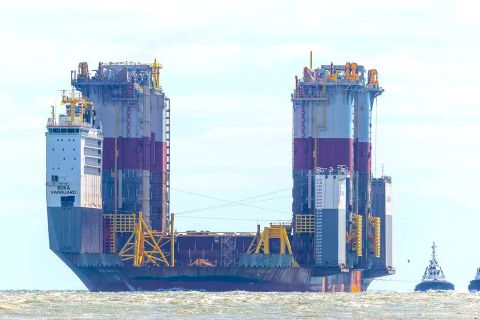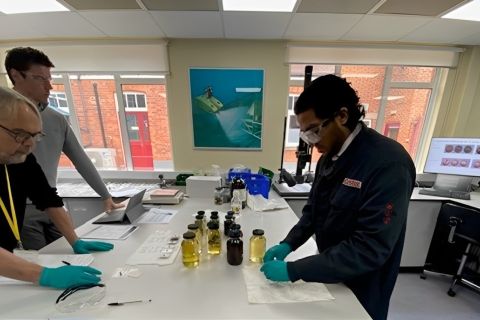After a decade of plummeting production, privatization in fits and starts, and shifting tax and legal codes, the Russian oil business seems back on track. The immense country has regained its rank as the world's second-largest crude oil producer, after Saudi Arabia. In February, it even briefly surpassed Saudi Arabia as the top global producer, thanks to the Middle Eastern country's compliance with OPEC production cuts. Russia is also the second-largest crude oil exporter behind Saudi Arabia, and firmly holds the crown as the world's largest natural gas producer and exporter. In 2001, the Russian stock market rose by the greatest percentage of any market in the world. Three years of economic expansion have now followed nine years of economic contraction, and the country is in the best shape it's been since the collapse of the Soviet Union in 1991. Oil and gas have been key drivers to this spectacular turn-around. "Overall, Russia's production of 7.3 million barrels per day in the first four months of 2002 is up 8.8% year-on-year," says a recent report from Commerzbank Securities. In each of the last two years, Russia's daily output has increased by a half-million barrels, and that trend is likely to continue. Lehman Brothers analyst Paul Cheng says, "Given Russia's underutilized resource base and relatively low cash operating costs, we estimate Russia could increase daily production by 300,000 to 500,000 barrels annually during the next five years, depending on oil prices." According to the U.S. Energy Information Administration, Russia's net oil exports this year are projected to reach 5.01 million barrels of oil per day. Its gas production should hit 21.2 trillion cubic feet of gas, of which some 6.7 Tcf will be exported. Significantly, this rebuilding of the Russian oil industry has been largely internal, accomplished without substantial help from foreign firms. The handful of major vertically integrated firms that dominate Russian oil-Lukoil, Yukos, Surgutneftegaz, Tyumen Oil, Tatneft, Sibneft, Slavneft and Rosneft-have reinvested billions of rubles during the past several years in exploration, production and field rejuvenation. Two speakers noted Russia's positive direction earlier this year at the annual Cambridge Energy Research Associates' conference in Houston. "From Russia, you should not expect any surprises," Mikhail Khodorovsky, Yukos chief executive, said. "We want to expand our own markets, but low oil prices would be a problem, so dialogue with OPEC will continue to take place." Khodorovsky claimed that the West has greatly underestimated Russia's potential. "The world energy community uses very old data, indicating about 46.5 billion barrels of reserves. But in 2000, new audited reserves of the top four Russian companies are that much alone. If you look at the top 10 companies, reserves are 81 billion barrels. We just need more investment and more from the service companies." Andrei Illarionov, special economic advisor to President Vladimir Putin, added, "Let me be absolutely clear: Russia will produce and export more oil in the coming years. It is inevitable." Government reforms are also taking hold, accelerated by the ambitions of Putin to gain Russia respect and entree into the World Trade Organization, NATO, the G-8 and other Western groups. Indeed, in June the U.S. Department of Commerce granted Russia, formerly the standard-bearer of communism, market economy status under U.S. trade laws. This paves the way for further trade between the two countries. On July 3, the first very large crude carrier (VLCC) anchored offshore Galveston, Texas, to deliver 2 million barrels of Urals-grade crude from Yukos. A second shipment was expected at press time. Russia plans to boost its export capacity by 100,000 barrels per day in 2003, thanks to a new pipeline agreement that will allow shippers to deliver crude to a Croatian port that is capable of handling tankers larger than Turkey's Bosporus Strait will allow. Despite its recent gains, can Russia deliver in the future? This is one of the most hotly debated questions in international energy circles today. Some experts think the growth potential is high and that the country's oil will compete strongly with supplies from the Middle East. Others claim Russia is merely harvesting the easy pickings after a decade of economic, regulatory and political turmoil. They think Russian oil production can climb for another two or three years at most before serious declines set in once again. Indeed, Russia's oil industry still faces some key problems, not the least of which are aging and inadequate infrastructure, locations remote from markets and services, and fields handicapped by poor production practices. "Anybody who thinks Russian oil will somehow displace Saudi oil needs to go back to the drawing board," says Matthew Simmons, head of Simmons & Co. International, Houston. "The average Saudi well produces 5,000 barrels a day, but the average Russian well, across all the production associations, produces 50 or 60 a day, and a lot of water. This could be dangerous thinking." Nonetheless, Russian oil and gas is in ascendancy, and interest in doing business in the country also is reviving. What's especially intriguing for many firms is that Russia offers a spectrum of opportunities for both small independents and multinationals, as well as for producers and service companies. One area where a trio of small Western firms has been surprisingly successful is in the West Siberia Basin. This is the heart of Russia's oil industry, its premier producing province, and home to several of the world's largest oil and gas fields. According to the EIA, the basin, which is more than twice the size of the entire state of Alaska, contains more than 600 oil fields and nearly 150 gas fields. It is the largest intracratonic basin in the world, extending from the Ural Mountains east to the Yenisey River and from the Kazakh Uplands north to the Kara Sea. Teton Petroleum In the boreal forests of Siberia, notorious for swampy terrain, mosquitoes, political prisoners and unforgiving winters, one small U.S. firm has fought hard to bring an oil project to fruition. Steamboat Springs, Colorado-based Teton Petroleum, the only publicly traded company in the U.S. that focuses just on Russian oil, has raised gross production on the Eguryak license from 360 barrels of oil per day in 1998 to more than 5,500 barrels per day at press time. The 70-square-mile license is owned and operated by Goloil, a Russian joint-stock company. Teton holds a 50% interest in Goloil before payout and a 35.29% interest after payout. The Eguryak license lies on the northern plunge of the Nizhnevartovsk Arch, a large structural feature in the Middle Ob region of the West Siberian Basin. About 10 kilometers to the south of the license, and also located on this feature, lies Samotlor, Russia's largest oil field. The EIA estimates Samotlor, a supergiant discovered in 1961, contained ultimate recoverable reserves of more than 20 billion barrels of oil. Production in the Middle Ob region is mainly from clastic rocks in the Lower Cretaceous, draped over anticlines or domes. These tend to be combination structural/stratigraphic traps. Jurassic sandstones and siltstones also produce in places, mainly on structural features. Teton's license holds three fields: Eguryak, South Eguryak and Golevaya. To date, the company has been developing the Eguryak accumulation. Presently, 13 wells have been drilled-11 are producing and two are in progress-and proved reserves total 88 million barrels, gross. "When we took over the license, it had three shut-in wells that had been drilled in the late 1980s," says Howard Cooper, Teton president. That was part of its attraction-as it had not been developed, the license carried no environmental liabilities, did not have an existing workforce that had to be maintained, and was not burdened by aging equipment. "It was a clean operation." Initially, Goloil produced the existing wells by trucking oil out of the license in the winter and barging it out on the Agan River during the summer. From 1997 until Goloil completed a pipeline in April 2001, production was shut-in due to weather six months of the year. Teton's partner in Goloil is Cyprus-based Petromed Ltd., headed by Zamir Abdoullaev, who also serves as chairman of the board of Goloil. "During the last two years, we have laid more than 40 kilometers of pipeline, drilled nine additional wells in the field and finished the commercial measuring unit," says Abdoullaev. The company's current focus is on completing a processing and separation facility on the license, drilling several additional wells and lowering operating costs. It is also implementing Western-style internal financial controls. Russia abounds in small and medium-size fields, which are perfect for companies the size of Goloil, he says. "We see there is a niche in the Russian oil industry for small independents, and we're looking forward to more growth." Cooper credits Petromed's participation as a crucial component of Goloil's success: "Having a good Russian partner is essential." Petromed has invested $6.6 million in Goloil to date to earn a half-interest, and now Petromed and Teton are continuing to invest equally in future development. Additionally, Petromed is a prominent oil marketer in Russia-a tremendous asset. There are three keys to Teton's accomplishments in Russia, says Chuck Strain, analyst with Torch Capital Group, Houston. "Teton controls the pace of the development, it has consistently brought on 500-barrel-per-day wells, and it has consistently had a good market for its oil." The amount of oil that can be exported from Russia is significant, as oil that is sold in the domestic market is price-controlled and only fetches about half that of export oil. Goloil exports about 35% of its production; in March 2002, its export barrels were fetching $22 apiece. Of that, $7.11 was spent on export duties, commissions, transportation, production taxes and royalties, says Strain. Lease operating costs, G&A, processing fees and profits tax totaled another $5.35. Net profits were $9.55 per export barrel. Teton's aim is to raise production on the Eguryak license to as much as 30,000 barrels per day, then add other 50- to 100-million-barrel fields to an all-Russian portfolio. "Our goal is to build Teton into a company that produces in the range of 100,000 barrels per day," says Cooper. The 30,000-barrel-per-day scenario is supported by a reserve estimate prepared by Boulder, Colorado-based consulting firm Gustavson Associates. It envisions development of 88 million barrels of proved and 142 million barrels of probable reserves via a waterflood project, with 174 producing wells and 58 injection wells. "Russia offers very good opportunities, because you can acquire proven, shut-in oil fields at between 30 and 40 cents per barrel. Right now, it's a very undervalued market," says Cooper. Karl Arleth, an outside director of Teton, says, "Teton is a little company that has defied all the odds and survived to the point where Russia is in a political and commercial upswing." Arleth was a vice president with BP, director of the Azerbaijan International Operating Co. and president of Amoco Poland Ltd. "Geologically, Teton's license has multi-hundred-million-barrel potential, and there is opportunity in the region to make this kind of play again." Khanty Mansiysk Oil Corp. Khanty Mansiysk is the name of a 1.3-million-acre region (and a city of about 50,000) that sits on the Ob River in Western Siberia east of the Ural Mountains. And now, it also is the name of a U.S. holding company, Khanty Mansiysk Oil Corp., which was formed by John Fitzgibbons in 1993. Fitzgibbons, a Harvard economics graduate, went to Russia in 1992 as part of a U.S. team advising the Kremlin on privatization. While there, he became intrigued by the opportunities to be found in the oil sector; shortly thereafter he founded KMOC. In 1996, Fitzgibbons recapitalized the company with private equity from U.S. and European institutions. In 1997 it bought interests in Russian oil companies, including 96% of KMNGG, a state-owned exploration outfit that had been partially privatized. Today, KMOC owns 100% of two Russian oil companies, 22% of another and 96% of another. All four have licenses in the West Siberia Basin and three of them are producing, from five fields. According to petroleum-engineering firm Ryder Scott, KMOC's proved reserves total 289 million barrels of oil per SEC guidelines; it currently produces 20,000 barrels per day, net, from the five fields. KMOC headquarters are in New York with offices in Moscow and Siberia, but in effect it is a Russian entity, says executive vice president and chief financial officer Gail Coleman. "We are not operating as a Western partner of a Russian company-we are a Russian company with international standards of control and access to Western capital. We pay Russian taxes and report using GAAP [generally accepted accounting principles]," says the former Salomon Brothers investment-banker. Most of the company's costs are ruble-denominated, but oil exports are paid in dollars, while sales to Russian domestic markets are in rubles. Fitzgibbons adds, "The license-holders are consolidated Russian legal entities, but virtually all the financing is done at the U.S.-holding-company level." KMOC's two principal producing assets are the Potanay Field about 100 miles west of Khanty Mansiysk, and East Kamennoye Field about 60 miles northwest of the city. Potanay contributes about 75% of KMOC's net production. Some 26 wells have been drilled in Potanay since the beginning of 1998, with 25 of these successful. Average well flows can be up to 800 barrels per day and can exceed 1,000. East Kamennoye Field produces from the Cretaceous at about 4,750 feet and from deeper Jurassic at 8,000 feet. Since the beginning of 1998, the company has drilled 22 wells there, all successful. Last year KMOC's companies drilled and completed 47 wells-mostly directionally from pads-with a capital investment of about $60 million. At any given time, KMOC runs nine to 14 rigs, of which it owns three. This year, the company is fracture-stimulating its existing wells; next year, it plans to drill as many as 100 new wells. "Most of our production comes from a combination of structural and stratigraphic Jurassic sands as they occur at Potanay," says board member and long-time oilman Mach Vaughn in Oklahoma City. "At East Kamennoye, production, which is growing quickly, is from Lower Cretaceous deltaic sands. They are part of a simple anticlinal structure that extends over a huge area and equates to dozens of Cretaceous fields in the western U.S. and Alberta. "It's as simple as a bedtime story, except for the weather, which in the winter slows us down a bit. There is a Russian labor rule that says you can't work when it gets to 40 degrees below zero." The challenge for KMOC is the same as for any oil company, says Fitzgibbons: to optimize production and do so efficiently. KMOC has been producing oil since 1997, and it has put considerable effort into reorganizing and consolidating the Russian companies so they can run more effectively. It employs about 850 people in Siberia. "We have very little exploration expense because our fields are fairly well delineated. Our capex is geared to increasing production, developing proven and some probable reserves, and investing in some processing facilities to make sure our oil is Transneft pipeline-ready," he says. Last May KMOC filed an S-1 with the Securities and Exchange Commission to go public via JP Morgan and UBS Warburg. It was set to begin its road show the second week of September; needless to say, those plans were shelved. The company is waiting on market improvements before it launches its offering. Says Fitzgibbons, "We can be patient. We have positive cash flow from operations that can fund what we are doing. EBITDA in 2001 was about $30 million and I'm comfortable saying it will be above that level this year. The bottom line is we are making money." Harvest Natural Resources "Russia is a country that has been producing oil as long as the U.S. has, maybe longer, but it did so in an isolated way with a lack of access to technology and capital," says Peter Hill, chief executive officer of Harvest Natural Resources (formerly Benton Oil and Gas), Houston. (For more on Harvest, see "Planting Hopefulness," Oil and Gas Investor, July 2002.) Harvest operates in Russia via Geoilbent, a joint stock company formed in 1991 with Russian partners to operate fields in Siberia. Currently, Harvest owns 34% of Geoilbent; its Russian partner, which recently merged with Itera, owns the rest. Ryder Scott estimates that on the four blocks and the 37,000 developed acres (of the 1.4 million acres involved), there are 87 million barrels of proved oil reserves. Some 26 million barrels have been produced to date, mainly from Cretaceous deltaic sediments. Geoilbent's main asset is North Gubkinskoye Field, located in the northern part of the Ob Basin. North Gubkinskoye is a large gas and condensate field with an oil leg, which has been developed exclusively as an oil field. There are 117 wells. In Soviet times, oil fields and gas fields were developed by discrete entities, and hybrid gas-condensate fields such as North Gubkinskoye were often overlooked. In 2001, North Gubkinskoye produced 14,200 barrels per day of 40-degree-gravity oil. Lifting costs run $2.17 per barrel, and another $8 is devoted to tariffs, taxes and transportation charges. Last year, Harvest's share of Geoilbent's earnings was $7 million. Currently, Geoilbent is flaring as much as 75 million cubic feet of gas per day, due to a lack of a gas plant and gas-sales contract. Hill plans to rectify that shortly: "We are designing a gas plant with a capacity of 100 million cubic feet per day, which won't damage the permafrost. We'll strip out the liquids and sell them into a product line, and sell gas into the Gazprom gas pipeline and oil into Transneft." Harvest intends to have the project financed by the end of this year, and to start construction early in 2003. Other opportunities exist on the licenses. Geoilbent discovered nearby Tarasov Field in 2000; presently that accumulation has 17 wells and is producing about 9,000 barrels per day. Harvest is not yet sure of the field's extent, and plans further development on the anticlinal structure. Managing costs is the biggest challenge, says Hill. "In Western Siberia, lifting costs are low, but it is hard work. The well rates are not high-many of the reservoirs are low-pressure and easily damaged, and have to be pumped." The Russian style is to pull wells hard, so production declines rapidly. Wells are generally drilled overbalanced. Cross flows, oil coming up behind the casing, coning and annular build-ups are all common problems. Russians also tend to work equipment hard until it needs to be fixed, discounting Western-style preventative maintenance. "Changing behaviors is a slow, transitional process. We're training a new generation in our way of doing business. We want to produce for value, not volume," says Hill. "The Russians are hugely pragmatic, however, and see things I would have never thought of." Hill believes Russia's reserves have been grossly underestimated and there is a lot of low-hanging fruit yet to be produced. "The world has woken up to the opportunities in Russia again, but this time those opportunities will be pursued in a more mature, thoughtful way." Improving investment climate There are lots of licenses and reserves buried in Russian soil, but there is not enough money to develop those fields, says Ilya Veller, New York-based vice president of Centre Invest Group and head of Russian equity sales. The firm targets U.S. or offshore hedge funds seeking to invest in Russian equities, emphasizing less liquid, newer firms but also including first-tier names such as Yukos and Lukoil. Today, investors are interested in getting into Russian oil, not only in pure blue-chip oil companies but also through direct investments in smaller oil companies, says Veller. "Investors like companies where it might be possible to come in with $10 million and get a seat on the board of directors, and be able to influence the future." That attitude gives rise to one of the most common problems-control issues. "Control is one of the biggest questions in these deals, and it's a Russian perception that if they lose control they will be forced out of the picture very soon." Corporate law in Russia allows minority shareholders to paralyze the life of a company, so the fear can be well-founded. Additional concerns about transparency and corporate governance also worry investors, although given the high-profile problems of late in several U.S. companies, this is a bit of a glass-house issue. Still, full public disclosure runs counter to the Russian penchant for secrecy. "Right now, large funds are not yet coming into Russia, because investors are waiting to see how corporate governance will improve. But Lukoil, Yukos and Surgutneftegaz are trying their best to deliver whatever U.S. fund managers want." But, other areas such as taxation have profoundly improved. Last year, corporate tax in Russia was reduced from 35% to 24%. Income tax on dividends was reduced from 15% to 6% for domestic investors, and for foreign investors the tax was slashed from 30% to 15%. Taxes for individuals are flat at 13%. Vostok Fund LP, headed by Houston-based president John Haskell, invests in Russian firms. The U.S. fund, started in 1997 by a private equity group in New York, buys Russian stocks and also makes direct investments. Vostok has positions in both Yukos and Teton Petroleum, as well as in companies involved in the mining, high-tech and agricultural sectors. Haskell recently relocated to the U.S. after living in Moscow for five years. "The biggest problem with the investment climate has been that people were very reluctant to look at anything in Russia. That made it much more difficult and expensive to raise money. Forward progress was very slow." While this has clearly been frustrating for the companies involved, it also has created opportunities for investors who are willing to look at situations that others won't consider. "Russia has done really well coming out of its 1998 financial crisis," says Haskell. "It didn't get much attention in the U.S., however, because people there were doing fine. But now that the U.S. stock market is down, and the problems with American corporate governance have been exposed, people are changing their attitudes toward investing in countries such as Russia." Clearly, Russia has the oil and gas reserves and potential, and is now opening up tremendously for Western investment. The risks today are in the political and commercial arenas, and those risks are at a level that many now view as manageable.
Recommended Reading
Chevron, Total’s Anchor Up and (Almost) Running
2024-05-07 - During the Offshore Technology Conference 2024, project managers for Chevron’s Anchor Deepwater Project discussed the progress the project has made on its journey to reach first oil by mid-2024.
Electric Hype vs. Hydraulic Reality: Advantages of Traditional Systems
2024-05-07 - Castrol's new fluid prevents gas hydrates in deepwater control systems.
EOG: Utica Oil Can ‘Compete with the Best Plays in America’
2024-05-06 - Oil per lateral foot in the Utica is as good as top Permian wells, EOG Resources told analysts May 3 as the company is taking the play to three-mile laterals and longer.
E&P Highlights: May 6, 2024
2024-05-06 - Here’s a roundup of the latest E&P headlines, including technology milestones and new contract awards.
US Oil, Gas Rig Count Falls to Lowest Since January 2022
2024-05-03 - The oil and gas rig count, an early indicator of future output, fell by eight to 605 in the week to May 3, in the biggest weekly decline since September 2023.




